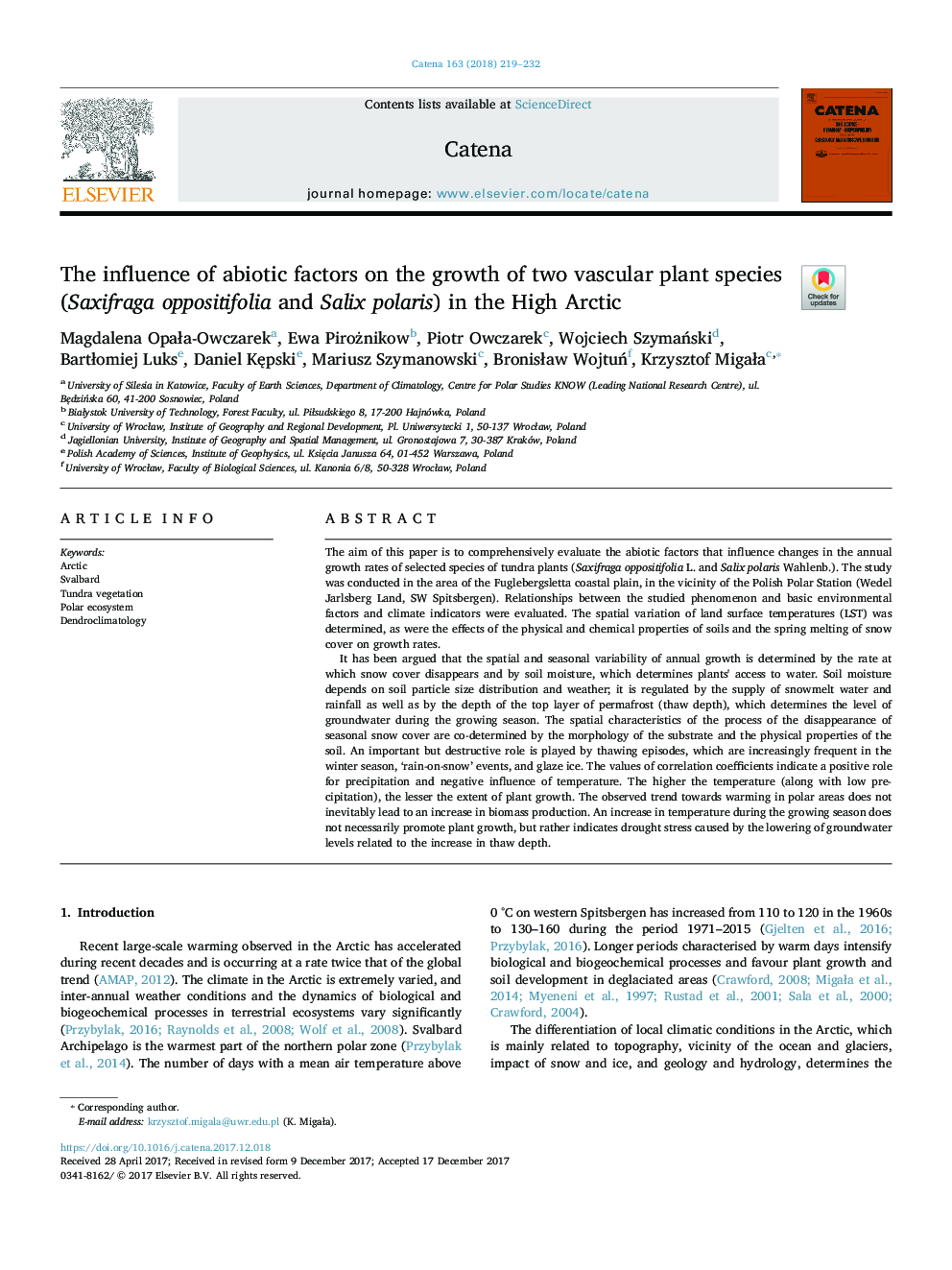| کد مقاله | کد نشریه | سال انتشار | مقاله انگلیسی | نسخه تمام متن |
|---|---|---|---|---|
| 8893694 | 1629191 | 2018 | 14 صفحه PDF | دانلود رایگان |
عنوان انگلیسی مقاله ISI
The influence of abiotic factors on the growth of two vascular plant species (Saxifraga oppositifolia and Salix polaris) in the High Arctic
ترجمه فارسی عنوان
تاثیر عوامل آبیوتیک بر رشد دو گونه گیاه عروقی (ساسی فراگا در مقابل قطب جنوب و سلیکس قطبی) در قطب
دانلود مقاله + سفارش ترجمه
دانلود مقاله ISI انگلیسی
رایگان برای ایرانیان
ترجمه چکیده
استدلال شده است که تغییرات فضایی و فصلی رشد سالانه به وسیله نرخ ناپدید شدن برف و رطوبت خاک تعیین می شود که دسترسی گیاهان به آب را تعیین می کند. رطوبت خاک بستگی به توزیع اندازه ذرات خاک و آب و هوا دارد؛ با توجه به عرضه آب ریخته گری و باران و نیز عمق بالای لایه ی بالای مرجانی (عمق خرد) تنظیم می شود که سطح آب های زیرزمینی را در طول فصل رشد تعیین می کند. ویژگی های فضایی فرآیند ناپدید شدن پوشش برف فصلی با توجه به مورفولوژی بستر و خواص فیزیکی خاک تعیین می شود. یکی از مهمترین و مخربترین قسمت های بازی، بخش هایی است که در فصل زمستان، حوادث باران بر روی، و یخ زدگی ظاهر می شوند. مقادیر ضرایب همبستگی نشان دهنده نقش مثبت در بارش و تاثیر منفی دما است. دمای بالاتر (همراه با بارش کم)، میزان رشد گیاه کمتر است. روند مشاهده شده نسبت به گرم شدن در مناطق قطبی به طور ناگهانی منجر به افزایش تولید زیست توده نمی شود. افزایش دما در فصل رشد، لزوما رشد گیاه را ترویج نمی کند، بلکه نشان دهنده تنش خشکی ناشی از کاهش سطح آب های زیرزمینی ناشی از افزایش عمق خلایق است.
موضوعات مرتبط
مهندسی و علوم پایه
علوم زمین و سیارات
فرآیندهای سطح زمین
چکیده انگلیسی
It has been argued that the spatial and seasonal variability of annual growth is determined by the rate at which snow cover disappears and by soil moisture, which determines plants' access to water. Soil moisture depends on soil particle size distribution and weather; it is regulated by the supply of snowmelt water and rainfall as well as by the depth of the top layer of permafrost (thaw depth), which determines the level of groundwater during the growing season. The spatial characteristics of the process of the disappearance of seasonal snow cover are co-determined by the morphology of the substrate and the physical properties of the soil. An important but destructive role is played by thawing episodes, which are increasingly frequent in the winter season, 'rain-on-snow' events, and glaze ice. The values of correlation coefficients indicate a positive role for precipitation and negative influence of temperature. The higher the temperature (along with low precipitation), the lesser the extent of plant growth. The observed trend towards warming in polar areas does not inevitably lead to an increase in biomass production. An increase in temperature during the growing season does not necessarily promote plant growth, but rather indicates drought stress caused by the lowering of groundwater levels related to the increase in thaw depth.
ناشر
Database: Elsevier - ScienceDirect (ساینس دایرکت)
Journal: CATENA - Volume 163, April 2018, Pages 219-232
Journal: CATENA - Volume 163, April 2018, Pages 219-232
نویسندگان
Magdalena OpaÅa-Owczarek, Ewa Pirożnikow, Piotr Owczarek, Wojciech SzymaÅski, BartÅomiej Luks, Daniel KÄpski, Mariusz Szymanowski, BronisÅaw WojtuÅ, Krzysztof MigaÅa,
